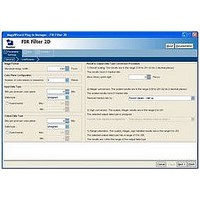IPSR-VIDEO Altera, IPSR-VIDEO Datasheet - Page 135

IPSR-VIDEO
Manufacturer Part Number
IPSR-VIDEO
Description
RENEWAL Of IPS-VIDEO
Manufacturer
Altera
Series
IP Suitesr
Datasheet
1.IPS-VIDEO.pdf
(202 pages)
Specifications of IPSR-VIDEO
Software Application
IP CORE, SUITES
Supported Families
Arria GX, Cyclone II, HardCopy II, Stratix II
Features
Common Avalon Streaming (Avalon-St) Interface And Avalon-St Video Protocol
Core Architecture
FPGA
Core Sub-architecture
Arria, Cyclone, Stratix
Rohs Compliant
NA
Lead Free Status / RoHS Status
na
- Current page: 135 of 202
- Download datasheet (6Mb)
Chapter 5: Functional Descriptions
Scaler
January 2011 Altera Corporation
Polyphase and Bicubic Algorithms
Algorithmic Description
This section describes how the algorithmic operations of the bilinear scaler can be
modeled using a frame-based method. This does not reflect the implementation, but
allows the calculations to be presented concisely. To find a value for an output pixel
located at (i, j), we first calculate the corresponding location on the input:
The integer solutions,( in
left corner of the four input pixels to be summed. The differences between in
( in
real-valued position that we want to read from. Call these errors err
precision of each error variable is determined by the number of fraction bits chosen by
the user, B
Their values can be calculated as:
The sum is then weighted proportionally to these errors. Note that because the values
are measured from the top-left pixel, the weights for this pixel are one minus the error.
That is, in fixed-point precision:
The sum is then:
The polyphase and bicubic algorithms offer the best image quality, but use more
resources than the other modes of the scaler. They allow up scaling to be performed in
such a way as to preserve sharp edges, but without losing the smooth interpolation
effect on graduated areas.
For down scaling, a long polyphase filter can reduce aliasing effects.
The bicubic and polyphase algorithms use different mathematics to derive their filter
coefficients, but the implementation of the bicubic algorithm is just the polyphase
algorithm with four vertical and four horizontal taps. In the following discussion, all
comments relating to the polyphase algorithm are applicable to the bicubic algorithm
assuming 4×4 taps.
O i j
in
in
where % is the modulus operator and max(a, b) is a function that returns the
maximum of two values.
i
û, in
i
j
= (i × w
= (j × h
2
j
û) are a measure of the error in how far the top-left input pixel is from the
fh
B
fv
and B
+ F in
+
in
in
B
)/h
)/w
fh
=
out
fv
i
out
, respectively.
F in
in
j
i
+
1
in
i
û, in
j
err
err
2
B
j
2
û) to these equations provide the location of the top-
i
j
fh
2
B
=
=
B
–
fh
fh
–
err
------------------------------------------------------------ -
--------------------------------------------------------- -
–
err
i
j
err
i
max w
max h
i
w
i
h
err
in
in
and
2
%w
%h
+ F in
j
in
in
B
fv
2
out
out
B
–
w
h
fv
out
err
out
i
–
+
err
j
+ F in
2
1 in
Video and Image Processing Suite User Guide
2
B
B
j
fv
fh
j
i
+
+
1
1 in
err
j
i
i
and err
err
err
i
j
2
j
. The
B
i
, in
fv
–
j
err
and
5–55
j
Related parts for IPSR-VIDEO
Image
Part Number
Description
Manufacturer
Datasheet
Request
R

Part Number:
Description:
CYCLONE II STARTER KIT EP2C20N
Manufacturer:
Altera
Datasheet:

Part Number:
Description:
CPLD, EP610 Family, ECMOS Process, 300 Gates, 16 Macro Cells, 16 Reg., 16 User I/Os, 5V Supply, 35 Speed Grade, 24DIP
Manufacturer:
Altera Corporation
Datasheet:

Part Number:
Description:
CPLD, EP610 Family, ECMOS Process, 300 Gates, 16 Macro Cells, 16 Reg., 16 User I/Os, 5V Supply, 15 Speed Grade, 24DIP
Manufacturer:
Altera Corporation
Datasheet:

Part Number:
Description:
Manufacturer:
Altera Corporation
Datasheet:

Part Number:
Description:
CPLD, EP610 Family, ECMOS Process, 300 Gates, 16 Macro Cells, 16 Reg., 16 User I/Os, 5V Supply, 30 Speed Grade, 24DIP
Manufacturer:
Altera Corporation
Datasheet:

Part Number:
Description:
High-performance, low-power erasable programmable logic devices with 8 macrocells, 10ns
Manufacturer:
Altera Corporation
Datasheet:

Part Number:
Description:
High-performance, low-power erasable programmable logic devices with 8 macrocells, 7ns
Manufacturer:
Altera Corporation
Datasheet:

Part Number:
Description:
Classic EPLD
Manufacturer:
Altera Corporation
Datasheet:

Part Number:
Description:
High-performance, low-power erasable programmable logic devices with 8 macrocells, 10ns
Manufacturer:
Altera Corporation
Datasheet:

Part Number:
Description:
Manufacturer:
Altera Corporation
Datasheet:

Part Number:
Description:
Manufacturer:
Altera Corporation
Datasheet:











